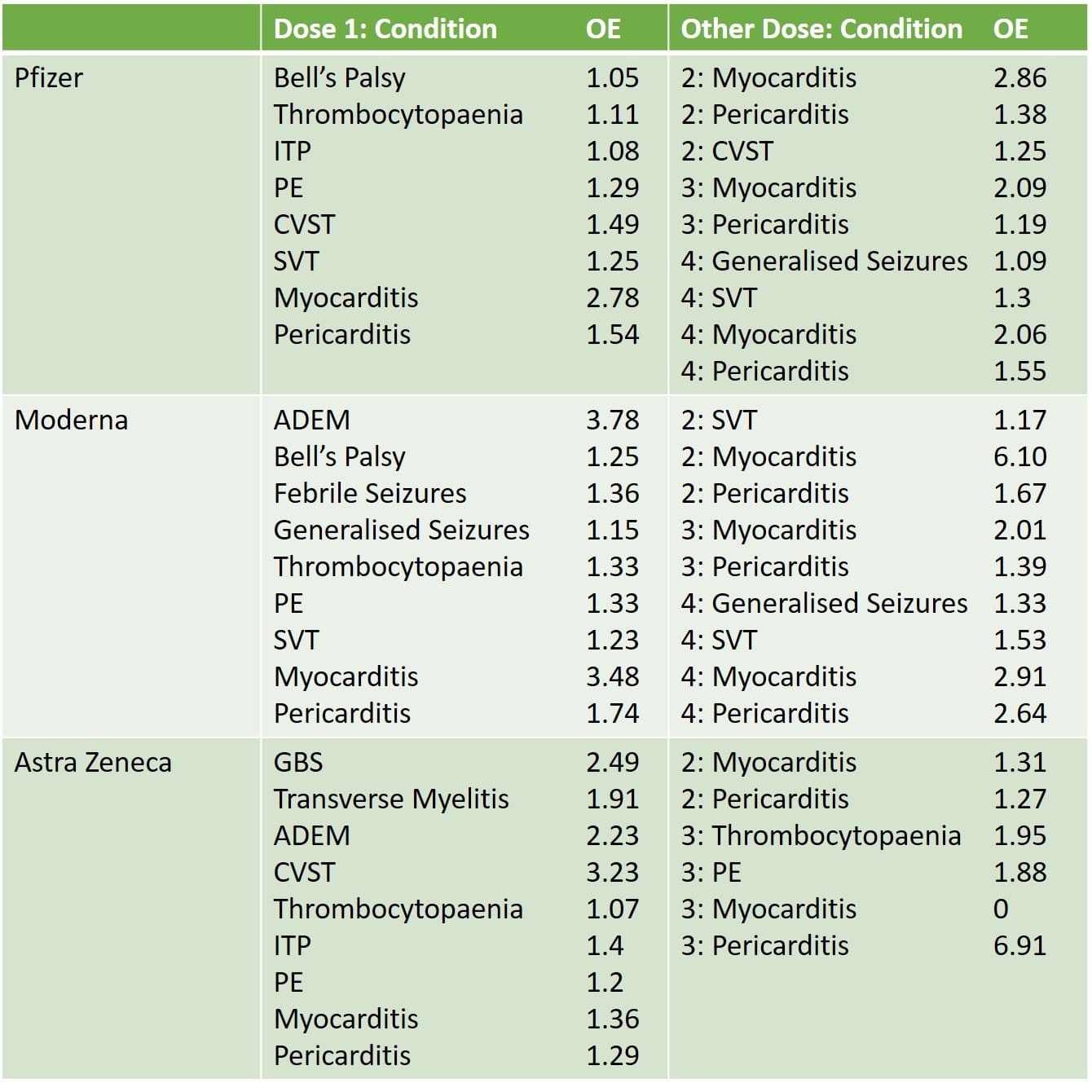New Zealand Doctors Speaking Out with Science
A recent study, Covid-19 vaccines and adverse events of special interest: A multinational Global Vaccine Data Network (GVDN) cohort study of 99 million vaccinated individuals, was published in the journal Vaccine and has reached the attention of news outlets in the mainstream media. This seems like a move in the right direction, but is it?
Initial Red Flags
GVDN, co-directed by New Zealand vaccinologist Dr Helen Petousis-Harris, were awarded over US $10.1 million to conduct the Global Covid Vaccine Safety (GCoVS) Project, to “facilitate comprehensive assessment of vaccine safety”. The money was awarded by the US Centers for Disease Control and Health & Human Services, who are known to receive significant financial benefits via royalties and licensing agreements with large pharmaceutical companies.
The GVDN website is also a member of the World Health Organization’s (WHO) Vaccine Safety Net (VSN) which aims to “help internet users find reliable vaccine safety information tailored to their needs.” This seems remarkably similar to the Trusted News Initiative, (TNI) who “work together to build audience trust and to find solutions to tackle challenges of disinformation.” See more about the propagandist nature and purpose of the Trusted News Initiative in this short video.
Both VSN and TNI are beneficiaries of pharmaceutical industry funding with a view to minimising the reach of so-called ‘anti vaccination’ views. This is a clear demonstration of the interconnections between the pharmaceutical industry, global health, mainstream media and research institutions. When considered in tandem with the WHO’s most recent Pandemic Agreement draft, these information control systems have a very clear intent to drown out and forcibly silence information which questions, challenges or opposes claims being made by WHO.

Skilled critical analysis of medical literature involves the ability to identify and understand the many types of research bias which can affect study results. Bias occurs when “systematic error [is] introduced into sampling or testing by selecting or encouraging one outcome or answer over others”. One of the sponsored activities of the GCoVS Project is to “develop communications to support vaccine confidence”. Combined with massive funding interests, this is an immediate red flag that their work is likely steeped in confirmation bias, defined as “seeking or interpreting evidence in ways that are preferential to existing beliefs, expectations, or hypotheses.”
Study Summary
GVDN researchers conducted an observational cohort study of over 99 million vaccinated individuals using data taken from a range of institutional and national databases from 10 sites in eight different countries. They looked for 13 adverse events of special interest (AESIs) with haematological (blood), neurological (brain and nerve) and cardiac (heart) outcomes occurring up to (and only) 42 days after administration of three vaccine products – Pfizer, Moderna and Astra-Zeneca. These were compared to ‘historic background rates’ of the same adverse events of special interest experienced in the same geographic regions, which were calculated and published by the GCoVS Project in October 2023.
The study periods differed across sites, depending on the dates of vaccine rollout commencement and data availability coming to an end. The periods spanned from December 2020 to August 2023.
The adverse events of special interest were selected from a pharmacovigilance compilation published by the Brighton Collaboration in 2020 and classified using standardised ICD10 codes. The thirteen AESIs studied were as follows. Neurological: Guillain-Barre Syndrome (GBS), Transverse Myelitis, Facial (Bell’s) Palsy, Acute Disseminated Encephalomyelitis (ADEM), Convulsions (generalised seizures) and
Convulsions (febrile seizures). Haematological: Cerebral Venous Sinus Thrombosis (CVST), Splanchnic Vein Thrombosis (SVT), Pulmonary Embolism (PE), Thrombocytopenia, Immune Thrombocytopenia (ITP). Cardiac: Myocarditis and Pericarditis.
The observed vs expected rates (OE ratio) of each event were compared across the three different genetic injections (both mRNA and DNA based). The OE ratio represents how many times higher the rate of an observed condition occurs compared to the expected background rate. The results are summarised in this table.

The authors concluded that their research “confirmed previously identified rare safety signals following COVID-19 vaccination and contributed evidence on several other important outcomes…” They also claimed that the risks of Covid-19 infection were far higher than the risks of vaccination.
What is Wrong With This Study?
In the discussion section of the paper, the authors identify some limitations to their study such as inconsistencies between data collection, quality and reporting between the 10 different sites. They also mention the potential for underreporting of adverse events of special interest.
There is a discrepancy in the New Zealand data. Te Whatu Ora data states 4,042,448 first doses had been administered by 16 February 2024. Yet the GVDN study indicates a vaccinated population of 4,151,269 by September 2022.

The New Zealand data only includes hospitalised patients. Many Bell’s palsy cases will not have been hospitalised. Due to lockdowns, inability to receive medical care within the 42 day window and misdiagnosis, some cases of all adverse events of special interest will not have been diagnosed within the study’s 42 day window, which is arbitrarily short for late presenting AEFIs.
The authors do not connect any underreporting with the truncated timeframe in their study of 42 days. This erroneously assumes that beyond six weeks post-vaccination, adverse events of special interest do not occur. One of the biggest risks associated with these genetic injections is the widespread and long lasting expression of the toxic spike protein. Both mRNA coding for spike protein and spike protein itself have been detected in samples six months after vaccination. This is one explanation for the ongoing, delayed adverse events being experienced by people whose last vaccination was a significant time ago.
The thirteen adverse events of special interest in the study are a small sample of the possible range of harms which are associated with the genetic injections. The multiple ways in which these products can damage the human body depend on where the mRNA travels to, and which cells in which organs express the spike protein. Also see mRNA Toxicity to learn more on the mechanisms of harm specific to the disclosed contents in the vials.
Studying a small sample of ‘rare’ adverse events in isolation from the full scope of potential harms ignores the totality of evidence. There were nine pages of adverse effects in the Pfizer data release. Many were serious and occurred far more frequently than myocarditis. With almost a hundred million patients the GCoVS Adverse Events of Special Interest study is powered to look at many more than just 13 AESIs.
In their discussion of myocarditis, Petousis-Harris et al repeat the oft-mentioned lie that it is mild and worse after the actual infection. They ignore the significantly worrying studies from Japan, Hong Kong, Thailand, Italy and Switzerland that speak to the widespread and protracted incidence of cardiac inflammation, and the many ways that the injections can cause a whole spectrum of cardiac diseases.
The authors make no mention of the concerns about expression of aberrant proteins. See our article on Frameshifting to learn more. They also ignore the concerns about DNA contamination in the vials, and subsequent integration into host DNA, which have the potential for long term and inter-generational harms. The phenomenon of death following vaccination, estimated to be up to 17 million worldwide, is completely absent from the study. Surely this is the most important AESI of all?
Perhaps the biggest issue of all with this study is the fact that the data is unavailable for independent evaluation. As explained by Dr Peter Doshi, associate editor of the British Medical Journal, discussing the absence of data transparency at an expert hearing in November 2021, “without data it’s not science.” This must be especially true when the science is produced by teams embedded in intricate networks of pharmaceutical industry profits and power.

With Covid being the leading cause of ‘coincidences’ AND fake studies, it is reasonable to question the integrity of the data presented, especially given the vast disconnect with what is happening on the ground in our heavily vaccinated countries.
The Study That Is Needed
We know Dr Petousis-Harris has access to all the New Zealand data and our former Covid Immunisation Register (where everyone is recorded, vaccinated or not). She has been paid to provide our personal health data to a private consortium. Presumably anonymised, that information should be released for scrutiny.
Further, she could very easily do a vaccinated versus unvaccinated study, even with just NZ data alone – we are sure everyone would give permission, for a truthful result – and tell us how many people have had common adverse events of special interest, such as blood clots, new autoimmune conditions, heart attacks, strokes, stillbirths, sudden death etc, in each group.
And where are the results of the post-vaccine symptom check study conducted on jabbed Kiwis in 2021, and the MoH myocarditis study that seems to have died suddenly?
Our Conclusion
Whilst it is refreshing to see the topic of vaccine injuries reach mainstream news, it is simultaneously disappointing to see that harms with delayed onset are ignored; harms continue to be claimed as ‘very rare’; and of less concern than the minimal risks associated with Covid-19 disease to most people. Our sense is that allowing the release of this paper for mainstream consumption merely programs audiences to believe these falsehoods against a burgeoning realisation amongst the populace, that our collective health has deteriorated significantly in the past three years.









